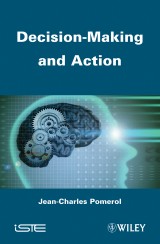Details

Decision Making and Action
1. Aufl.
|
139,99 € |
|
| Verlag: | Wiley |
| Format: | |
| Veröffentl.: | 27.12.2012 |
| ISBN/EAN: | 9781118588093 |
| Sprache: | englisch |
| Anzahl Seiten: | 256 |
DRM-geschütztes eBook, Sie benötigen z.B. Adobe Digital Editions und eine Adobe ID zum Lesen.
Beschreibungen
Making a decision, of any importance, is never simple. On the one hand, specialists in decision theory do not come within the reach of most policy makers and, secondly, there are very few books on pragmatic decision that are not purely anecdotal. In addition, there is virtually no book that provides a link between decision-making and action. <p>This book provides a bridge between the latest results in artificial intelligence, neurobiology, psychology and decision-making for action. What is the role of intuition or emotion? What are the main psychological biases of which we must be wary? How can we avoid being manipulated? What is the proper use of planning? How can we remain rational even if one is not an expert in probabilities? Perhaps more importantly for managers, how does one go from decision to action? So many questions fundamental to the practice of decision-making are addressed.</p> <p>This book dissects all issues that arise almost daily for decision-makers, at least for major decisions. Drawing on numerous examples, this book answers, in plain language and imagery, all your questions. The final chapter takes the form of a brief reminder - everything you have to remember to be a good decision-maker.</p>
<p>Introduction xi</p> <p><b>Chapter 1 What is a Decision, or What Does Decision Theory Have to Teach Us? 1</b></p> <p>1.1 Actions and events 1</p> <p>1.2 Probabilities 5</p> <p>1.3 Expected utility 7</p> <p>1.4 Subjective probabilities and rationality of the decision 12</p> <p>1.5 Caveats and recommendations 14</p> <p><b>Chapter 2 Scenarios and Conditional Probabilities 17</b></p> <p>2.1 Scenarios 17</p> <p>2.2 Compound probabilities 21</p> <p>2.3 Scenarios and conditional probabilities 24</p> <p>2.4 Decision tree 28</p> <p>2.5 Scenarios, information and pragmatics 32</p> <p>2.6 Pursuance of the scenarios and the "just one more push" 35</p> <p>2.7 Conditional probabilities and accidents 39</p> <p>2.8 Caveats and recommendations 41</p> <p><b>Chapter 3 The Process of Decision-Making and its Rationality, or What Does Artificial Intelligence Have to Teach Us? 43</b></p> <p>3.1 A decision as a problem 43</p> <p>3.2 Decision table 45</p> <p>3.3 The general process of decision-making 46</p> <p>3.4 Case-based reasoning 48</p> <p>3.5 The Olympian point-of-view, and H Simon’s view 51</p> <p>3.6 Information 54</p> <p>3.7 Limited rationality 57</p> <p>3.8 Heuristics 60</p> <p>3.9 Cognitive limitation 61</p> <p>3.10 Feedback on rationality in decisions 62</p> <p>3.11 Caveats and recommendations 64</p> <p><b>Chapter 4 Intuition, Emotion, Recognition and Reasoning or, What Does the Neurobiology of Decision-Making Have to Teach Us? 67</b></p> <p>4.1 Introduction 68</p> <p>4.2 Animal "decision" 69</p> <p>4.3 Recognition-primed decision 70</p> <p>4.4 The brain and emotion 73</p> <p>4.5 Short-term, long-term 78</p> <p>4.6 The Bayesian brain 83</p> <p>4.7 Caveats and recommendations 85</p> <p><b>Chapter 5 Decision-Making in the Presence of Conflicting Criteria, or What Does a Multicriterion Decision Aid Have to Teach Us? 87</b></p> <p>5.1 Preference structures 88</p> <p>5.2 Multicriterion decision aid 91</p> <p>5.3 Weighted sum aggregation 93</p> <p>5.4 Other aggregation methods 100</p> <p>5.5 Aggregation of votes 103</p> <p>5.6 Social choice and collective decision 105</p> <p>5.7 Individual reactions to multicriterion decision-making 109</p> <p>5.8 Constraints and multicriterion decision-making in organizations 110</p> <p>5.9 Caveats and recommendations 112</p> <p><b>Chapter 6 The Decision-Maker’s Psychology, or What Does Psychology Have to Teach Us? 115</b></p> <p>6.1 Introduction 116</p> <p>6.2 The decision-maker’s rationality and utility function 117</p> <p>6.3 Constructing the utility function 119</p> <p>6.4 Utility function in the risk 120</p> <p>6.5 Loss aversion and the endowment effect 125</p> <p>6.6 Biases related to the probabilities 126</p> <p>6.7 Self-confidence and the illusion of control 134</p> <p>6.8 Biases linked to memory 136</p> <p>6.9 Frame effect 140</p> <p>6.10 Level of reference and anchoring 144</p> <p>6.11 Rationalization and reinforcement 154</p> <p>6.12 System 1 or System 2? 156</p> <p>6.13 Biases or heuristics? 159</p> <p>6.14 Caveats and recommendations 162</p> <p><b>Chapter 7 Context of the Decision: Intention, Commitment, Trust, Fairness, Authority and Freedom 167</b></p> <p>7.1 Intention and commitment 168</p> <p>7.2 Trust and reciprocity 171</p> <p>7.3 Fairness 177</p> <p>7.4 Freedom and responsibility 180</p> <p>7.5 Authority 182</p> <p>7.6 "Leadership" in organizations 186</p> <p>7.7 Rationality between logic and probabilities 189</p> <p>7.8 Rationality and "good reasons" 192</p> <p>7.9 Caveats and recommendations 197</p> <p><b>Chapter 8 Action: Giving the Impetus or Managing 201</b></p> <p>8.1 Deciding and acting 202</p> <p>8.2 Quick or slow decision-makers 203</p> <p>8.3 Consensual or imperative decision-makers 208</p> <p>8.4 To act or to manage? That is the question 212</p> <p>8.5 Reflect long, project long term: strategic planning and decision-making in organizations 217</p> <p>8.6 Feedback and learning 221</p> <p>8.7 Conclusion 226</p> <p>8.8 Caveats and recommendations 226</p> <p><b>Chapter 9 Vade Mecum of the Acting Decision-Maker 229</b></p> <p>9.1 That which depends on you, and that which does not 229</p> <p>9.2 That which depends on you: information, imagination and the process of decision-making 230</p> <p>9.3 That which depends only on you: learning and planning 232</p> <p>9.4 That which depends on nature: the pitfalls of probabilities 234</p> <p>9.5 That which depends on our human nature: the pitfalls of the human brain 236</p> <p>9.6 That which depends on other people: conflicts and manipulation 239</p> <p>9.7 What the result depends on: your style and your action 241</p> <p>9.8 And finally... 243</p> <p>Bibliography 245</p> <p>Index of Names 263</p> <p>General Index 269</p>
<p><strong>Professor Jean-Charles Pomerol</strong>, Department of Computer Science at Université Pierre et Marie Curie of Paris, France.


















